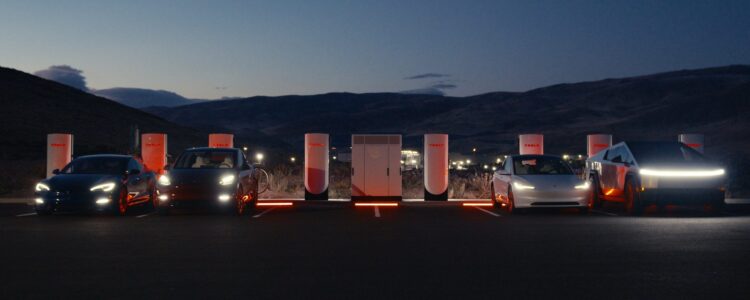Tesla has officially launched its V4 supercharging cabinets, set to double charging speeds to an impressive 500 kW per stall, with capabilities for Tesla trucks reaching up to 1.2MW per stall. The transition to these new power cabinets marks a significant upgrade for Tesla’s supercharging infrastructure, enhancing the charging experience for a range of electric vehicles (EVs).
Key features of the V4 supercharging cabinet
The V4 superchargers are designed to support vehicles with 400-1000V architectures, enabling faster charging speeds. Among the Tesla lineup, the Cybertruck will benefit most, achieving charging speeds 30% quicker when plugged into V4 stations. Currently, Tesla vehicles like the Model 3 and Model Y can charge at 250kW, but future models may unlock even greater potential at these upgraded sites.
The V4 system boasts up to eight charging stalls per cabinet, doubling the capacity compared to the four stalls offered by existing V3 cabinets. Max de Zegher, the director of Tesla charging in North America, highlighted the upgraded system’s efficiency, stating that “no more DC busbar between cabinets” is needed, allowing power to transmute directly from a single V4 cabinet to eight stalls. This shift promises easier installations, reduced complexity, and cost-effective solutions without compromising performance.
Tesla claims the V4 cabinets bring a 2% efficiency improvement, which, while it may sound modest, contributes to significant energy savings. Currently, Tesla superchargers deliver over 5 TWh of energy annually, translating to about 100 GWh of waste heat. By minimizing waste, Tesla aims to enhance the overall sustainability of its charging network.
Coming next year
With the V4 design, Tesla envisions a faster deployment of new supercharging stations, reducing the footprint required for installation. The first V4 stations are already in the permitting phase, with expectations for site openings in 2025. This gradual rollout will bolster Australia’s supercharger network, which currently features over 100 sites and more than 600 stalls primarily utilizing the V3 cabinets.
Although some recent installations, like the one in Albury, have begun using the V4 stall design, they still operate on V3 cabinet capabilities, charging at a maximum of 250 kW. Several other upgraded sites, about 15 nationwide, continue to employ V3 technology, leaving some uncertainty regarding future developments for the new V4 cabinets across the 30+ planned supercharger locations in Australia.
Moreover, Tesla’s advancements are not limited to its vehicles alone. They aim to offer charging capabilities that facilitate faster connection for various vehicles, accommodating drivers of non-Tesla EVs with longer cables designed to reach diverse charge port locations without blocking neighboring stalls.
As the market for electric vehicles continues to expand, Tesla’s commitment to technology and efficiency enhances user convenience and sustainability. With its growth strategy focusing on improved charging speeds and better site efficiency, Tesla is positioning itself as a key player in the EV infrastructure market. The next step in EV evolution seems promising, as Tesla aims to cater to both its customers and the broader electric vehicle community.





